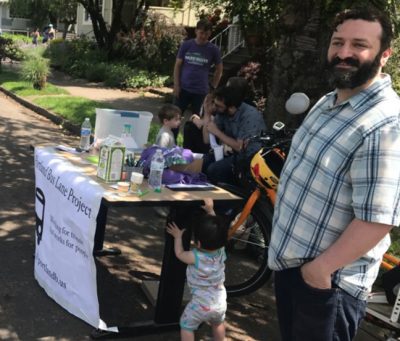
More dedicated lanes for buses might be an idea whose time has come in Portland. At least that’s how it appears given the support that the Portland Bus Lane Project has received after it launched just two weeks ago.
The effort is being spearheaded by lawyer and activist Alan Kessler. Kessler turned his passion for more reliable and efficient public transit into an organized effort after a May 4th tweet of gridlock on the Hawthorne Bridge gained attention.
Since then, Kessler has built a website and social media presence, garnered headlines, built up an email list (he has about 140 people signed up already), and even tabled at the recent Sunday Parkways event.
“The vast majority of comments we received [at Sunday Parkways] were supportive,” he shared with us yesterday. “We heard over and over from folks how well bus priority works in other cities they’d lived in and visited.”
Much to Kessler’s surprise, he said many people who stopped by his booth had already heard about his efforts. One of those people was Portland City Commissioner Nick Fish. “We were excited when he pulled up and grabbed a card.”
Advertisement
#WeNeedBusLanes pic.twitter.com/DL2yCHEyxe
— PortlandB.us (@portland_bus) May 18, 2017
Kessler’s initial focus has been on setting aside the outside lane of the Hawthorne Bridge as bus-only. That’s a county facility and he’s contacted County Commissioner Jessica Vega Pederson to make sure the issue is on her radar. Beyond Hawthorne, there are many other locations where buses should get priority over single-occupancy vehicles. Kessler thinks its imperative to make buses faster and more reliable if Portland wants to reach its adopted policy goals for climate change, health, housing, and the local economy.
Kessler has also been involved with housing and bicycle activism in Portland. He said he’s struck at how popular bus-only lanes are by comparison. “I don’t get the same feeling of backlash that seems to come with bicycle or housing advocacy. People like the buses, would like them to work well, and will be willing to organize around that issue. We just need a clear path forward and some help from our elected representatives.”
Tomorrow night (5/25) Kessler will host the first ever meeting for this new group. If you want to get involved with, “A group of citizens working to improve the state of transit in the Portland Metropolitan region,” you are encouraged to stop by.
Catch the Bus!
Portland Bus Lane Project Meetup
Thursday May 25th, 5:30 pm
The Commons Brewery (630 SE Belmont, meeting is upstairs)
— Jonathan Maus: (503) 706-8804, @jonathan_maus on Twitter and jonathan@bikeportland.org
BikePortland is supported by the community (that means you!). Please become a subscriber or make a donation today.



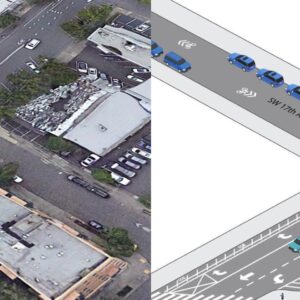
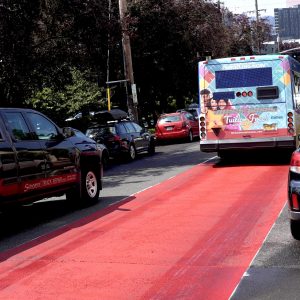
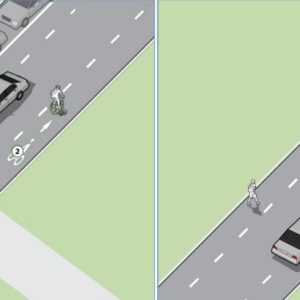
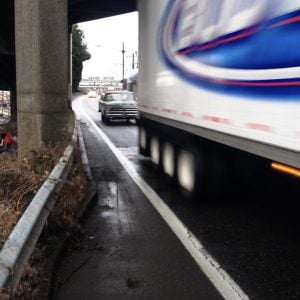
Thanks for reading.
BikePortland has served this community with independent community journalism since 2005. We rely on subscriptions from readers like you to survive. Your financial support is vital in keeping this valuable resource alive and well.
Please subscribe today to strengthen and expand our work.
Hillsdale has one dedicated bus lane for 200 feet. Why not bridges?
Here’s my litmus test for this idea: let’s picture an alternative version of Portland where we have dedicated bus lanes on key routes so buses quickly move people around during rush hour. Then let’s suppose that, in this reality, there was a proposal to remove these bus only lanes in an attempt to free up space for single occupancy vehicles. Would we really be going for that? Would it have a chance at all of going through? If not, why aren’t we working toward achieving this alternative reality now?
The incumbent situation always has a huge advantage.
You have a point, but to be fair your insistence on this (and the many permutations of that principle) is not just a reminder but also a way to further strengthen this bias toward the status quo. If instead we were to argue that this isn’t an iron rule but something to overcome—something that can be overcome—I think we’d make more progress.
“Optimism is a political act. Those who benefit from the status quo are perfectly happy for us to think nothing is going to get any better. In fact, these days, cynicism is obedience.” -Alex Steffen, The Bright Green City in Sun Magazine
Optimism is subversion? Interesting thought.
In all fairness, it probably depends on where the lanes would be. For example, I ride along 6th every day at rush hour. The road is busy with buses and trains moving people through. It’s impossible to argue that’s not way more efficient than just letting the cars stack up.
But despite the peak time of day, there are hardly any cyclists. So any solution that provides space for bikes that reduces the number of cars that can get through is going to be a hard sell.
My guess is that decent support can be found for bus lanes wherever it makes sense — but enough buses need to pass through for it to make sense.
False equivalence.
Yes and many more ideas. Even something like increasing HOV lanes to 3+ rather than 2+ would make a difference – provided the law is enforced.
“increasing HOV lanes to 3+”
Nope. Unfortunately studies I discovered when we recently discussed HOV lanes here, showing they aren’t adopted much anymore suggest that even at a cutoff of 2 US Americans in cars can’t by and large be bothered to carpool as a way to avoid congestion, which of course suggests that it isn’t as big of a problem as we were led to believe. That is or appears to be the perspective of the majority of SOV occupants, but what Alan’s proposing instead takes the perspective of those stuck in buses which is why it is so brilliant.
What HOV lanes? We have, what, 3 miles of HOV lanes in the entire state?
“…and even tabled at the recent Sunday Parkways event.”
The verb “table” is pretty much the opposite of what Kessler is doing, but more power to him doing it, anyway.
It’s not an uncommon way to describe the activity of standing at a table and engaging a crowd. See, e.g.:
http://meetings.okstate.edu/tabling
http://www.aauw.org/resource/how-to-tabling/
https://npengage.com/nonprofit-fundraising/takes-two-table/
If AAUW uses it, it must be OK. Gotta love language morphs. Maybe Google will catch up before long. Anyway, thanks and best wishes.
You too. 🙂
I’ve heard for over 2 decades now, especially among volunteers who table at events. The other main form, “tabling a motion”, as becoming increasingly rare, as fewer groups use Robert’s Rules. Both forms of “table” are highly technical and have very limited use or meaning.
However, my favorite use is from the graphic novel series Cerebus – “Fine Table Wine” = Wine made from fine tables.
The trick is to harvest the tables late-season.
This brings up all kinds of questions about house wines.
This is a good example of the differences between UK and American usage. In Britain, ‘table’ means to quash or reject, in the U.S. it means to propose.
On bended knee, he tabled to his true love.
…but how did he chair the discussions?
Plenty of times I don’t understand my UK friends, but that’s not one of the cases we’ve tripped over. I’ll take David’s and Alan’s word that it’s used in place of “staffing a table” (obvious from the picture in the article), but I doubt the phrase “table the motion” is foreign to many Americans. It’s in the American Heritage dictionary, for instance:
https://ahdictionary.com/word/search.html?q=table
tr.v. ta·bled, ta·bling, ta·bles
1. To put or place on a table.
2. To postpone consideration of (a piece of legislation, for example); shelve.
3. To enter in a list or table; tabulate.
Idioms:
1. Up for discussion: Her new offer is on the table.
2. Put aside for consideration at a later date.
In short, it means up for discussion, and also not up for discussion.
It’s a bad word, and by bad I mean good.
He was one bad pool player!
Yeah, like, he ran the table.
Specifically it’s a contranym where the context dictates whether it means one thing or the exact opposite.
Other examples: trim, fast (to hold fast vs. to run fast), seed (seeding a field vs. a watermelon). Language is amazing.
Good word! So, then there’s ‘blow’ and ‘suck’ which, as a contranymous pair, can be synonyms or antonyms. Yes, amazing!
Back on-topic, here’s Martyn Ashton tabling &c: https://youtu.be/HhabgvIIXik
Nerds.
🙂
werd nords?
Thank you, Alan Kessler! 🙂
You’re welcome! If you’d like to help out (even just with an occasional email to elected reps) please sign up at: https://portlandb.us
What? Exert MYSELF? 🙂 Will do.
The most practical future of urban transportation ( in additional to bikes that is) is buses using dedicated lanes and pull-outs for stops, combined with shared autonomous electric vehicles to provide connection to bus stops for those two far to walk. Climate change and oil depletion will quickly doom the future of the petroleum fueled personal motor car and urban density and bottlenecks ( bridges, tunnels etc) limit the growth of door to door transit in full-size one person vehicles on a purely logistical basis.
These are common and work well in San Francisco. Good to see the push in Portland!
Dedicated bus routes on every major arterial, super frequent buses, toll 26 West, increase cost of parking downtown. Incentivize transit and cycling through tax breaks.
As a bus driver and a bike rider, this is an idea who’s time has come!
Frankly, why WOULD a normal person, with a normal life and all the pressures of time and money choose to ride a bus? The reasons are becoming less and less with TNCs and neighborhood greenways. I can get where I need much quicker via bike than car during rush hour. There is just not a lot of incentive for me to choose bus which is slower, less comfortable and more logistically convoluted.
However: the simple fact remains that we have limited and non-expandable roadways and more densification. We’ve got to find a better way to move people or they are going to go ballistic and start demanding road expansion. We already are seeing this in regards to the lack of critical thinking on display with the Rose Quarter I-5 project.
Buses are the cheapest and most flexible option for moving lots of people.
It would be cheaper still if we had remote “drone” drivers like the Vancouver BC Skytrain system.
The average commuter lives 7 miles from work. On a bus, that’s probably going to work out to at least an hour each way for most people, plus getting to/from the bus, plus waiting.
If you don’t like having time to do things, pleasant environments, or personal space, this is just the ticket.
My wife is 10 miles from her job; it does take an hour door to door by bus. She can drive it in anywhere from 35-50 minutes depending on traffic. It’s not too hard for me to imagine bus lanes cutting the bus travel time down to the 45-50 minute range, at which point she would probably switch. The idea that we need to take 2 tons of metal everywhere we go, then park it all day, seems crazy to me — what a waste of money, energy and space!
It is a waste of a bunch of things.
Sadly, riding the bus is a waste of time for most people. Once that problem gets fixed, buses become much more attractive.
Excellent cause! I do believe that priority transit lanes are the best way to get the most out of Portland’s roads. Creating priority bus lanes will speed up bus service and reduce space for private vehicles, creating a nice push-pull dynamic that will get people out of their cars and onto more space-efficient mass transit. This is the sensible way to address congestion
2 dumb questions:
1. Is Bus-only better than HOV (including carpools?) Obviously, either option offers better human throughput and latency, than mixing with SOVs. Freight might be slower, but it still moves.
2. Since we just built a new bridge for MAX/Streetcar/Buses, why are only two bus lines using it?
I don’t mean to nay-say — I just want clarity of options and benefits.
Bus+carpool lanes make sense to me, but the carpoolers will probably get irritated with constantly stopping behind the bus. In fact, if you’re sharing a lane with the bus, you might as well just take the bus, right? Maybe if there were limited areas with few or no bus stops where car pools and buses share a lane (e.g., over the Hawthorne bridge) it would be a net positive.
I wouldn’t necessarily object to Bus and HOV, provided HOV was redefined to only include motor vehicles carrying 80% of their rated capacity, with a minimum of three occupants. Thus an 8 seater SUV would need six occupants, a five seat compact would need four. I see lots of big SUVs in the HOV lane with 2 people, but really, those can carry a lot more.
They can carry more, but they don’t contribute noticeably more to congestion than smaller cars.
BTW, most subcompacts are rated for 5 people. The good news is that if you buy a full size pickup with no rear seat, you’d only need two people 🙂
I don’t like the complications associated with varying the occupancy requirement based on capacity. I heard someone complaining once about going to court to fight a ticket in a place with that system. She had a pickup with an extended cab with two fold-down seats. Her view was the seats didn’t count, while the cop’s was that they did. The hearing was an ordeal with discussion of whether those were really seats or not. I don’t remember the outcome.
There’s no fairness involved in the rules either way. I use the Seattle lanes often. Much of the Friday northbound lane use is families on their way to the ferries and their San Juan weekends, or a parent with kids. There aren’t that many people who can conveniently do 3- or 4-person carpooling.
It’d be practically impossible to enforce though.
This is a fair question. My hunch is that HOV lanes are often not effective cause they’re not restrictive enough and the restrictions on them are not enforced. A study on the effectiveness of HOV lanes in reducing air pollution and congestion says the evidence is mixed:
http://journals.sagepub.com/doi/abs/10.1177/0885412212451028
Another focussing on California’s HOV lanes found that roads without HOVs allows same throughput of people as roads with HOV lanes: http://www.sciencedirect.com/science/article/pii/S0968090X07000435
For bus-priority lanes, on the other hand, there was a very convincing case study from Dublin about the effectiveness of its bus lanes:
https://drive.google.com/file/d/0B9bkLBISl4kbR2V3WTFHSUg4Mnc/view?usp=sharing
You don’t mind if I take an Uber in the HOV, do you?
Seattle cabs definitely use the I-5 HOV lanes as express lanes. It’s a minority of the traffic in the lane, so not a big deal, I think.
The 4 and the 10 should be routed over the Tillicum, but Trimet fails to create better connections to the central eastside as part of the project. A flyover ramp crossing over the UP rail line connecting to SE 7th would have permitted potentially even routing the 14 over the new bridge.
There already is a fly-over bridge that was built over UPRR tracks to the Tillicum right near OMSI. It is dedicated, car-free, only for transit. It is nearly brand-new, and was built a few years ago. It carries very, very few passengers. It is only for the Portland Street Car. I only ever see empty street cars using it.
And you’re right about using the Tillicum for more bus lines, we have already built a public transit bridge with dedicated, car-free service in Portland. Problem is, not too many people find this convenient. We also have many car-free bus only lanes in downtown portland – this article seems to ignore these facts. The idea of bus-only lanes are great, but Portland has many unique bottlenecks and pinch points in the transport network which are created by rivers, train tracks, freeways, and mountains. So, to eliminate use for some users in these bottlenecks, and create a dedicated road lane that will be unused for most of the minutes of the day by any vehicle (such as the Tillicum is mostly unused most of the minutes of the day) is to not understand how Portland’s unique bottlenecked traffic is created.
If city wants to keep cars out of downtown, they need to prevent cars from entering city at the city borders with the suburbs – park and ride, etc. All the city’s highways and arteries all come into town and get stuck around downtown bottlenecks during rush hour. Additional dedicated bus lanes on some bottlenecks won’t really help. Current congestion on the Hawthorne has more to do with current construction closure on the Morrison.
Anything that moves the focus towards buses and away from rail is good in my opinion.
Only if the focus on bus’ means they can freely move through the infrastructure. I know rail is expensive, but I can’t imagine taking a I84 W during rush hour unless it had a completely dedicated line.
Perfect timing, after years of removing lanes from town.
I’m not sure I’m following. Harbor Drive was taken out, but are there other lanes you are referring to? A road diet tends to actually increase lanes (for all users) though many fail to realize this. And this Bus lane isn’t actually removing a lane either but changing the criteria (density if you will) of those vehicles permitted to use it.
Increased density per individual vehicle, but maybe lower density per lane.
I think bus only lanes need to carry a LOT of bus lines at high frequencies. A bus only lane that only serves one or two bus lines at 15-20 minute intervals, and thus moves only 160-320 persons per hour, isn’t a great idea. Point is, Trimet will need to reconfigure its routes and frequencies to make this work.
As I suggested a while back, I see this as a dynamic problem, where the increased constraint on driving is leveraged into higher bus ridership.
Besides, one of the rationales for an HOV lane was always psychological: those stuck in traffic are supposed to have direct ocular experience of the free flow/empty lane next to them. If that proximate free flowing lane isn’t a motivator then perhaps the problem they consider being stuck in traffic to be isn’t that bad after all.